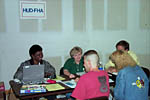

| Volume 1, Issue 1 |
"We are also planning for the next stage in the recovery--the the process of actually rebuilding not only the demolished physical structures, but the social and economic fabric in many communities all at once." |
Community Builders, Public Trust Officers Help Families Recover, Communities Rebuild Community Builders and Public Trust Officers sprung into action following the May 3rd tornadoes which ripped through communities in and around Oklahoma City, Tulsa, and Wichita, Kansas, leaving devastation in their tracks. The tornadoes caused over 40 deaths, and left over 11,000 homes either totally destroyed or uninhabitable. HUD personnel are playing a critical role in the immediate and long-term recovery efforts. Within hours of the disaster, Community Builders were out of the office and into neighborhoods assisting victims, already assessing damage, and compiling lists of available vacant units to accommodate those families who found themselves homeless. "I have been working in Wichita and Hayesville (Kansas) to assess damage, serving as a bridge between the community and the Public Trust officers back at our office to ensure that residents are housed and cared for," said Community Builder Fellow Nancy Barros, describing the initial stages of her on-site role. Barros brings extensive disaster-relief experience from her years at the Red Cross to the HUD response team. HUD’s assistance goes further than the personal, on-site effort of people like Nancy. After initial damage was assessed, HUD announced acceleration of Community Development Block Grant (CDBG) funds, extension of current grant deadlines, special emergency provisions to assist disaster victims with Federal Housing Administration mortgages, and availability of HUD staff to assist where needed. A $250,000 technical assistance service grant will enable local governments to utilize highly specialized experts in the fields of finance to assist in the recovery effort. Nancy Barros says that part of her role is to ensure that communities are aware of these resources as the rebuilding process begins. In Haysville and Wichita, Barros has helped facilitate each community’s access to CDBG resources. "We are here to help these communities quickly understand their options," she explained. HUD is achieving Secretary Cuomo’s vision for a flexible disaster response approach that empowers communities and establishes community driven partnerships with other federal, state, and local agencies. Community Builders are hard at work on the front lines, representing a critical part of the federal disaster response team that is dispatched in times of crisis. Recently, Community Builders in Oklahoma City, Tulsa, and Wichita, Kansas have relocated to FEMA Field Offices, making it easier to provide assistance to homeowners seeking any kind of relief for their losses and to work with local authorities in rebuilding. "We are also planning for the next stage in the recovery ---the process of actually rebuilding not only demolished physical structures, but the social and economic fabric of life in many communities all at once," says Community Builder Fellow Bill Tolbert, a former community development official for the City of Dallas, Texas who understands that communities must focus on their long-term recovery. Beyond their official roles, HUD personnel have been working in the FEMA warehouse sorting tons of clothing and developing a computerized inventory to assist in control of donated items. Many members of the HUD offices have volunteered their evenings to assist in the cleanup of neighborhoods and damaged schools. "We are all experiencing the satisfaction of knowing that we’ve been able to help our neighbors and our community in an immediate and tangible way," says Margaret Milner, Senior Community Builder in Oklahoma City. "The right people, at the right time, with the right resources are essential to effectively administer a disaster response," says Francis Gros Louis, a HUD disaster response specialist who has helped support Oklahoma and Kansas efforts for the Office of Special Actions. While the damage from the tornadoes was vast, Barros points out that it could have been much worse. Most of the windows in a 62 unit senior housing community in Haysville, Kansas were destroyed. Fortunately, the building manager had previously conducted disaster drills, familiarizing residents with emergency procedures. As the tornado approached, residents gathered for safety on the bottom floor. No residents were seriously injured. |
